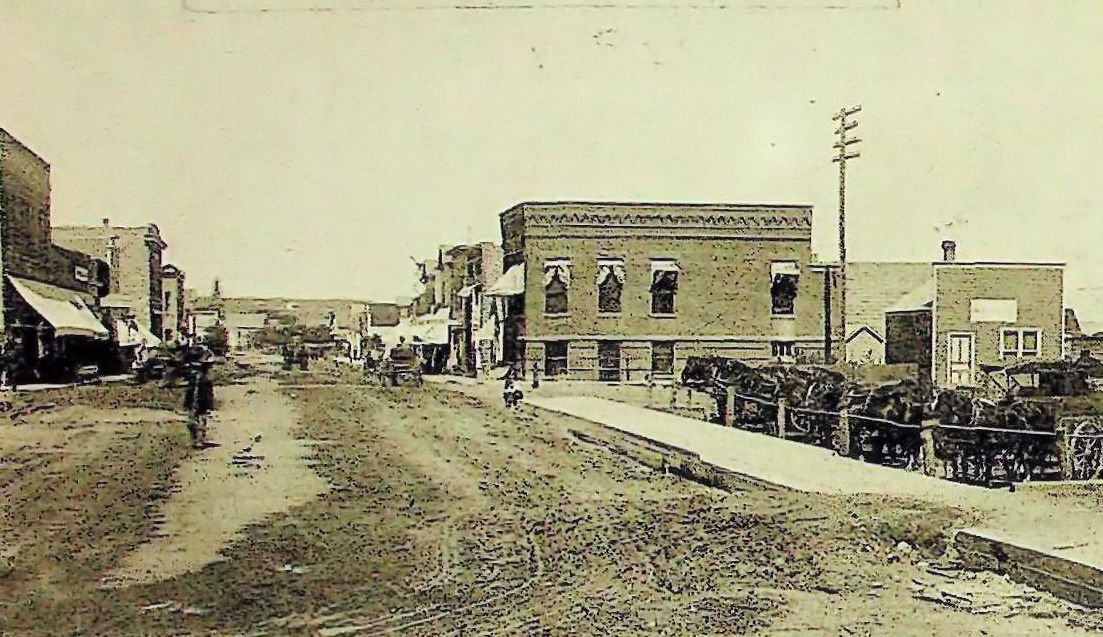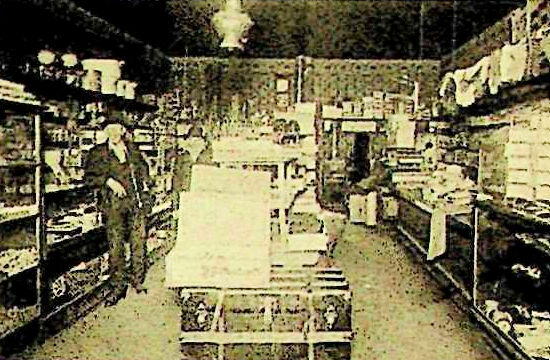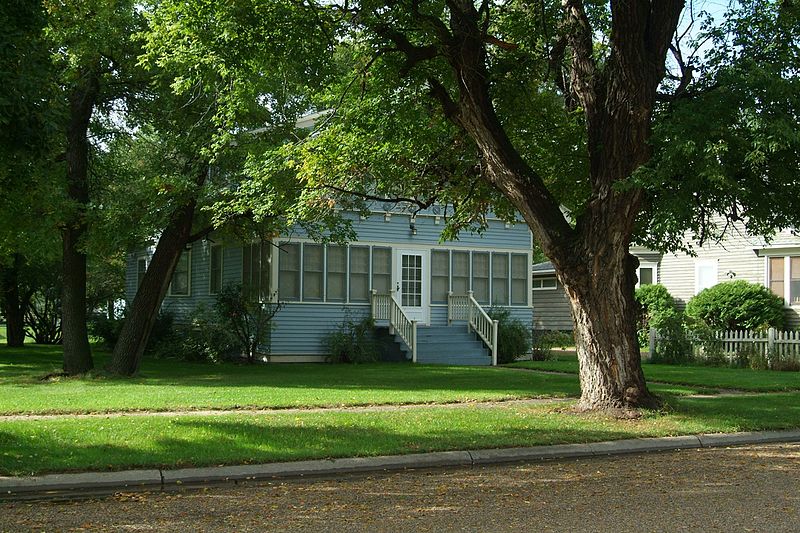|
A great portion of the Velva information is resourced in MCHENRY COUNTY, Its History and Its People, 1885-1985, also North Dakota Place Names by Douglas Wick and Origins of North Dakota Place Names by Mary Ann Barnes Williams.
A Township [Township 153, Range 80] and a city. This settlement began in 1886 as the second Mouse River post office in the southeast quarter of section 22-153-80, Velva Township. The name was changed in 1893 to Velva by Soo Line Railroad officials, noting the velvet-like appearance of the Souris River valley at this site. The post office adopted the name November 18, 1893 with John Downing as Postmaster. The elevation is 1511, the Zip Code is 58790, and a peak population of 1,330 was reached in 1960. Currently the largest city in McHenry County with a 2018 population of 1204. The village incorporated in 1902, and it became a city in 1905 with Gust Livdahl mayor. Television newsman Eric Sevareid [see Sevareid house below] was born here in 1912. Ernest M. Sands, who became mayor in 1961, was North Dakota Lieutenant Governor 1981-1985. Velva bills itself as the "Charlolais" Capital [French breed of cattle] of North Dakota.
August Peterson, born In Hedermora, Sweden, on June 22, 1847 has become known as the founder of Velva. In 1883 Peterson arrived in what is now known as Velva to visit a brother, Charlie. Shortly after Peterson's arrival his brother passed away leaving part of his land to August. Peterson sold forty acres of the land to the railroad and some land to the city which later became the city Park. Peterson's cabin is located in the park, having been given to the city some years ago.
Some Early Day Businesses

Main Street - Looking North - 1909
 Muus Brothers General Store. Velva's first business, opened in a tent in 1893 while the Soo Line Railroad was building through the area. The owners soon erected a frame building south of the tracks, then moved to the Stickles building for a time. In 1901 they moved into the new stone building on Main Street. Muus Brothers General Store. Velva's first business, opened in a tent in 1893 while the Soo Line Railroad was building through the area. The owners soon erected a frame building south of the tracks, then moved to the Stickles building for a time. In 1901 they moved into the new stone building on Main Street.
 L. T. Erickson and son had a men's clothing store next to the Muus building. In 1905 the Iris Theater was built there. L. T. Erickson and son had a men's clothing store next to the Muus building. In 1905 the Iris Theater was built there.
 Two doors further north Dr. Johns opened his office in 1901. Two doors further north Dr. Johns opened his office in 1901.
 The Bentson Drug Store opened in 1901 next to the doctor's office. In 1909-1916 the drug store was owned by Flnkenhagen and the name was changed "Velva Drug". Dr. Johns then moved his office to the rear of the drug store. The Bentson Drug Store opened in 1901 next to the doctor's office. In 1909-1916 the drug store was owned by Flnkenhagen and the name was changed "Velva Drug". Dr. Johns then moved his office to the rear of the drug store.
 Penn's hardware opened in 1900 next to the Bentson Drug. Penn's hardware opened in 1900 next to the Bentson Drug.
 Merriman Hall was erected in the early 1900's north of Penn's Hardware. It was a two story building housing a restaurant on the first floor and a ball room on the second which was also used for lodge meetings, shows, plays and other entertainment. Merriman Hall was erected in the early 1900's north of Penn's Hardware. It was a two story building housing a restaurant on the first floor and a ball room on the second which was also used for lodge meetings, shows, plays and other entertainment.
 The Merchants State Bank opened in 1903 and first conducted business next to Merriman Hall. The bank later moved to the sandstone building where the People's State Bank is now. The Merchants State Bank opened in 1903 and first conducted business next to Merriman Hall. The bank later moved to the sandstone building where the People's State Bank is now.
 Welo's Department Store was started in 1901 by Tobias Welo and was located where the Hotel Berry is now. In 1905 the store moved to the present Welo Block on Main Street. Welo's Department Store was started in 1901 by Tobias Welo and was located where the Hotel Berry is now. In 1905 the store moved to the present Welo Block on Main Street.
 The People's State Bank opened by Art and Ann Kumm in 1924 was in the former Merchants State Bank building. In Simcoe they had operated a bank from 1915 to 1925. In 1969 they purchased the Sand's Hardware building and erected the present facility. The People's State Bank opened by Art and Ann Kumm in 1924 was in the former Merchants State Bank building. In Simcoe they had operated a bank from 1915 to 1925. In 1969 they purchased the Sand's Hardware building and erected the present facility.
 Dickinson and Nichols Hardware and Funeral Parlor opened in 1905 north of the present People's State Bank. Mr. Dickinson took over the business in 1946. Dickinson and Nichols Hardware and Funeral Parlor opened in 1905 north of the present People's State Bank. Mr. Dickinson took over the business in 1946.
 First State Bank opened In 1903 with G. P. Sivertson as cashier. It was built across from the Muus Building with a barbershop in the basement. Later the building housed the Velva Journal office for a time. First State Bank opened In 1903 with G. P. Sivertson as cashier. It was built across from the Muus Building with a barbershop in the basement. Later the building housed the Velva Journal office for a time.
 The Kirkwood Hotel, a two story hotel and restaurant north of the First State Bank was built in the early 1900's with Hans Christianson as owner and operator. It burned in 1903. The Kirkwood Hotel, a two story hotel and restaurant north of the First State Bank was built in the early 1900's with Hans Christianson as owner and operator. It burned in 1903.
 The Polar Hotel, a two story hotel and restaurant built in the early 1900's was on the east side of Main Street where Verg's Market was later. The Polar Hotel, a two story hotel and restaurant built in the early 1900's was on the east side of Main Street where Verg's Market was later.
 G. W. McKnight 1902-1946, was Velva's first druggist. His first store was just north of the Polar Hotel. G. W. McKnight 1902-1946, was Velva's first druggist. His first store was just north of the Polar Hotel.
 The Russell House was west of Nelson's livery stables and called "The Velva Land Mark". It was a two story restaurant and rooming house built by Tom Berry In 1907 and at first called the Berry Hotel. After the Russells bought it, it was known as the Russell House. Russell sold It to Robert Rowan in 1946. The building later burned. The Russell House was west of Nelson's livery stables and called "The Velva Land Mark". It was a two story restaurant and rooming house built by Tom Berry In 1907 and at first called the Berry Hotel. After the Russells bought it, it was known as the Russell House. Russell sold It to Robert Rowan in 1946. The building later burned.
 M. E. Stickles and sons built a M. E. Stickles and sons built a  two story brick building in 1906 where they operated a general store with offices on the second floor. Later there were apartments there. The building was demolished in 1983. two story brick building in 1906 where they operated a general store with offices on the second floor. Later there were apartments there. The building was demolished in 1983.
 C. W. Stafford and son founded the McHenry County Journal in 1900. They sold to W. H. Francis in 1910 and in 1917 the name was changed to the Velva Journal. In
about 1980 the newspaper consolidated with the Drake and Anamoose papers and the name was changed to the McHenry County Journal Register. C. W. Stafford and son founded the McHenry County Journal in 1900. They sold to W. H. Francis in 1910 and in 1917 the name was changed to the Velva Journal. In
about 1980 the newspaper consolidated with the Drake and Anamoose papers and the name was changed to the McHenry County Journal Register.
 The Hotel Berry was built by Tom and Belle Berry and officially opened with three hundred invited guests attending an open house held on December 20, 1906. The hotel was considered by traveling men to be the best one The Hotel Berry was built by Tom and Belle Berry and officially opened with three hundred invited guests attending an open house held on December 20, 1906. The hotel was considered by traveling men to be the best one  on the Soo Line west of Minneapolis. In 1908, when city water was brought to Velva, the hotel water meter showed 1,400 gallons used the first week. Hot and cold baths with soft spring water could be had for 35 cents. In 1908 Berry sold the hotel to Mr. and Mrs. Charles Swanson who made many improvements over the years. In 1910 a reception was held in the hotel for Governor John Burke and years later, Governor Arthur Link stayed there during his first campaign trip around the state. Carl Olson purchased the hotel in 1945 and the dining room was closed in 1949. In 1954 Mr. Olson's son James W. and family moved into the hotel to help manage it. On June 30,1979 another open house was held, this time to observe the closing of the business which had been in operation for seventy-three years. James and Mabel Olson still [1985] reside in the hotel which was placed on the National Register of Historic Places in 1982. on the Soo Line west of Minneapolis. In 1908, when city water was brought to Velva, the hotel water meter showed 1,400 gallons used the first week. Hot and cold baths with soft spring water could be had for 35 cents. In 1908 Berry sold the hotel to Mr. and Mrs. Charles Swanson who made many improvements over the years. In 1910 a reception was held in the hotel for Governor John Burke and years later, Governor Arthur Link stayed there during his first campaign trip around the state. Carl Olson purchased the hotel in 1945 and the dining room was closed in 1949. In 1954 Mr. Olson's son James W. and family moved into the hotel to help manage it. On June 30,1979 another open house was held, this time to observe the closing of the business which had been in operation for seventy-three years. James and Mabel Olson still [1985] reside in the hotel which was placed on the National Register of Historic Places in 1982.
 Oslie's Cash Racket Store was located in the approximate area of the new Velva Drug Store on the east side of Main Street. The owner, A. J. Oslie, Oslie's Cash Racket Store was located in the approximate area of the new Velva Drug Store on the east side of Main Street. The owner, A. J. Oslie,  was one of the first settlers to come to the Mouse River valley area east of Velva. The store was similar to our present day [1985] variety stores. It was in operation between 1907 and 1924 by Mr. Oslie and for a few years afterward by his daughter Emma. Those who were youngsters during the time it was in operation remember their first taste of Hershey bars and a variety of candy and gum with names that are still familiar. was one of the first settlers to come to the Mouse River valley area east of Velva. The store was similar to our present day [1985] variety stores. It was in operation between 1907 and 1924 by Mr. Oslie and for a few years afterward by his daughter Emma. Those who were youngsters during the time it was in operation remember their first taste of Hershey bars and a variety of candy and gum with names that are still familiar.

The Sevareid House is listed on the National Register of Historic Places
405 2nd Street, West
Click on pictures for larger views.
Some pictures were provided to the Centennial. The Cash Racket Store by Mrs. Emil Harness [Margaret] and the 1909 Main Street by Mrs. Claude Green. The Berry Hotel and Stickles sources are unknown.
The Granville State Bank picture is credited to Publichall, CC BY-SA 4.0 via Wikimedia Commons
|